Characterization of pegylated copolymeric micelles and in vivo pharmacokinetics and biodistribution studies
Abstract
The aim of this study was to evaluate the influence of pegylated copolymeric micelle carrier on the biodistribution of drug in rats. The copolymers were synthesized via a modified ring-opening copolymerization of lactone monomers (ϵ-caprolactone, δ-valerolactone, L-lactide) and poly(ethylene glycol) (PEG10,000 and PEG4000). The molecular weights and the polydispersities of synthesized copolymers were in the range of 15,000–31,000 g/mol and 1.7–2.7, respectively. All of the pegylated amphiphilic copolymers were micelles formed with low CMC values in the range of 10−7–10−8M. The drug-loaded micelles were prepared via a dialysis method. The average particle size of micelles was around 150–200 nm. The cytotoxicity in terms of cell viability after treated with PCL–PEG, PVL–PEG, and PLA–PEG micelles was insignificant. PCL–PEG and PVL–PEG micelles without branch side chain in structures had higher drug loading than PLA–PEG micelles. In vitro release profiles indicated the release of indomethacin from these micelles exhibited a sustained release behavior. The similar phenomenon was also observed in vivo in rats. The pegylated copolymeric micelles not only decreased drug uptake by the liver and kidney, but also prolonged drug retention in the blood. © 2005 Wiley Periodicals, Inc. J Biomed Mater Res Part B: Appl Biomater, 2006




